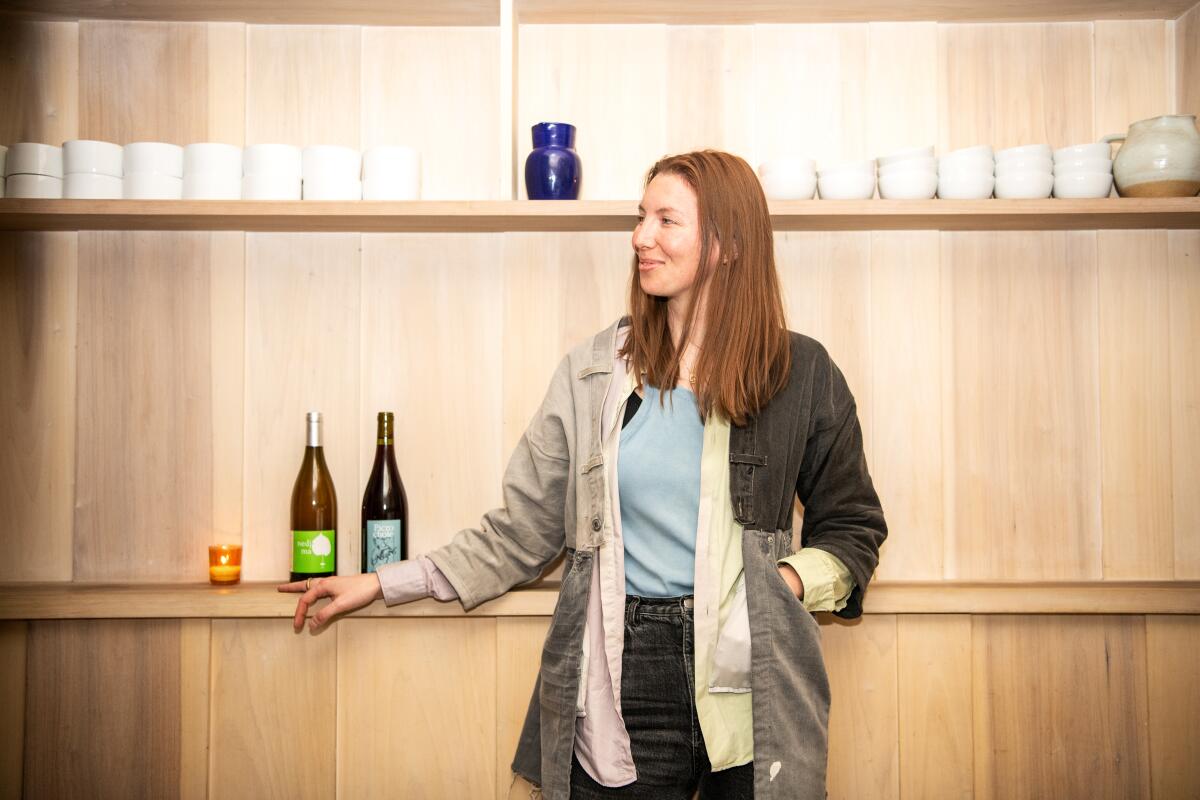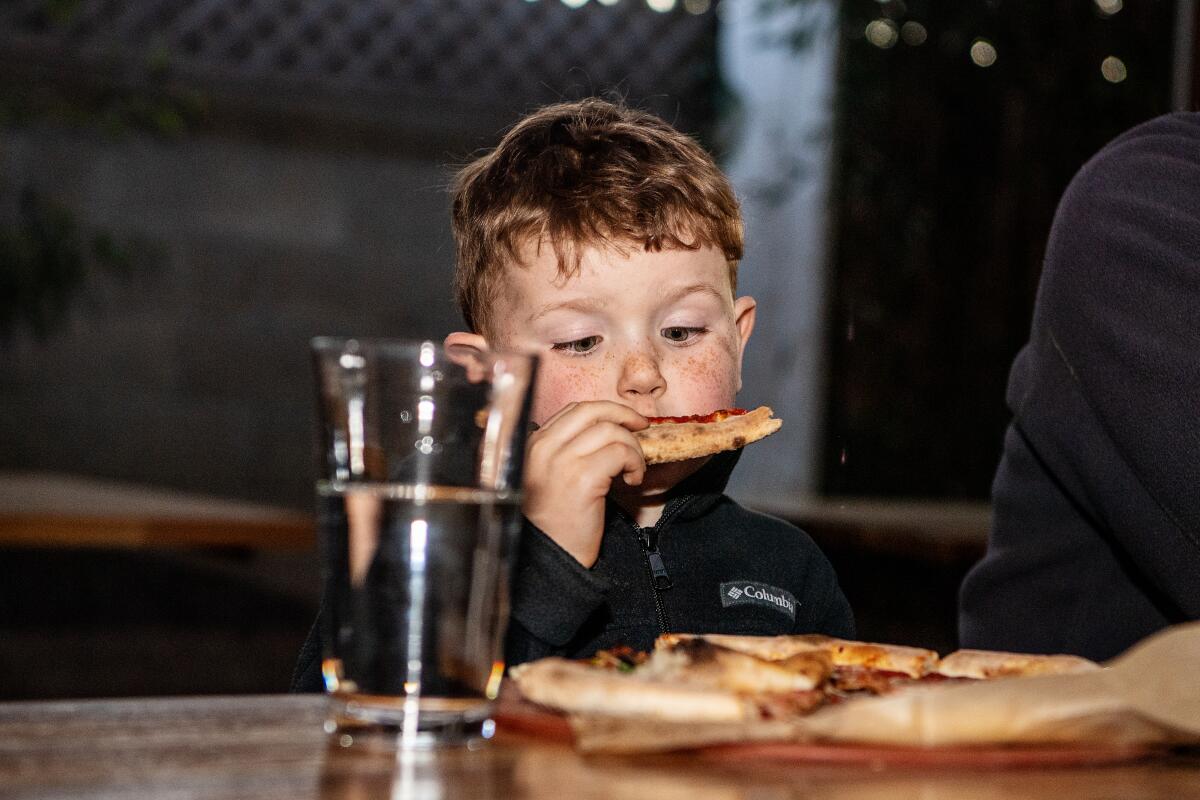Newsletter: A critic and a somm discuss the art of exceptional wine service

- Share via
Not long after I arrived in Texas in early 2006, soon after starting work as the dining critic for the Dallas Morning News, I was out to dinner with my friends Patrick and Frankie. They knew I was trying to stay anonymous as long as possible in a new town. (It never lasts.)
Eat your way across L.A.
Get our weekly Tasting Notes newsletter for reviews, news and more.
You may occasionally receive promotional content from the Los Angeles Times.
We were at a now-closed restaurant called Lola, which was known for its exceptional and fairly priced wine list. I fell into an elaborate discussion with owner Van Roberts about the most appropriate white Burgundy to order — which Puligny-Montrachets were showing leaner finesse, which Chassagne-Montrachets might be a better option given the range of dishes we’d chosen.
When Roberts walked away from the table, Patrick and Frankie burst out laughing. “Oh, so you think you’re going to stay an international man of mystery when you talk like that about wine? No one does that!”
Their reaction has always stayed with me. They were right, and it bummed me out. I have no extraordinary knowledge of wine, but I have enthusiasm. My work privileges me with plenty of practice in this kind of dialogue with sommeliers, and it helps me avoid feeling intimidated, judged, overwhelmed or under-informed. Many diners do feel these kinds of things around ordering wine in restaurants, understandably. It’s an esoteric subject, and restaurants can be haphazard around decoding its mysteries.
I thought about all this while writing a roundup of great places to drink wine in Los Angeles. Anonymity be damned, I never stopped having those conversations with somms. They’re the best way I know to have an exceptional wine-drinking experience in a restaurant, especially when ordering a bottle.
The places that stand out for me defuse the intimidation — sometimes with wacky, on-point annotations (Ashley Wells at All Time is particularly good at it), but more often with a tableside chat during which I feel heard. It’s the best advice I can offer: Give the somm a chance to delight you, to surprise you. Look up the wine list online, if it’s available, to see what you’re getting into. Regardless, ask for guidance and expect to be heeded on price range, flavor preferences and preferred level of experimentation. If something doesn’t feel right? Thank them and beg off. I’d rather drink a gin and tonic than commit to a bottle of wine that I felt pressured into.
During several dinners over the last year at Kismet in Los Feliz, I was particularly impressed by the restaurant’s engaged, accessible wine service. Beverage director and general manager Kae Whalen ventures far into natural wine territory — an area of even deeper arcana for most of us. Whalen’s bottle list is five or six small pages and rotates constantly, organized simply by “white,” “red,” “skin contact/orange” and so on. I talked with Whalen, who uses “they” pronouns, about some of the restaurant’s strategies for connecting with customers around wine.

“Sometimes with by-the-glass lists I’ll write short, prescriptive notes, but I tend to steer away from addressing flavors,” they said. “You know, ‘Tastes like a stone cup filled with muddled blackberries.’ ”
Whalen prefers to focus on the winemakers — to personalize them and highlight the processes they use to make their wines: “The best times I have with customers is when I can say, ‘Hey, I’m really excited about this producer.’ ”
“I try to figure out where the clientele is coming from — whether they want to be in a safe place (and safe doesn’t mean boring) or whether they want to push themselves,” Whalen said of their approach.
“People who tell me they are curious about natural wine, that they want to experience a new set of flavors and a new energetic experience (if I can get a little woo woo), I steer them toward skin contact wines.”
I mentioned to Whalen an experience at Kismet where I was with a date who had not enjoyed our previous forays into orange wines; he liked a more traditional, dark-fruit, fuller-bodied profile. We were both very happy with a Domaine Sauveterre Jérôme Guichard Gamay a staffer suggested. “With convergent tastes, the goal is a compromise that doesn’t feel like a compromise,” Whalen said.
And if you feel anxious about the bottle you’re ordering? “The first rule is: If you don’t like it, we’re not going to force you to drink it or pay for it,” Whalen said. “We can offer it to other customers by the glass, or use it for staff education.”
Then, they pointed out something distinctive about how they write the bottle list: They space out the names of each wine, which helps it all feel less scrunched and daunting. In keeping with Whalen’s philosophy, they also list the names of the producers first, distinguishing them in all caps. That bit of typography helps the customer latch on to something and facilitates conversation.
It brought to mind a Food Twitter moment a few weeks ago, when Helen Rosner posted a shot of a wine list where, the way it was written, she didn’t even know what words from the list’s truncated descriptions to say aloud to describe what she wanted to order. A, um, lively discussion ensued.
The smartest suggestion I gleaned from the thread was the idea to bold or otherwise highlight the most helpful words, much in the way Whalen uses all-caps. It steers to the same point: The more empowered the dining public grows, the more wine professionals need to think through ways to make wine service a more egalitarian experience. Radical thinkers like Whalen are leading the way.
Enjoying this newsletter? Consider subscribing to the Los Angeles Times
Your support helps us deliver the news that matters most. Become a subscriber.
Ask the Critics
Is the coronavirus outbreak affecting the kinds of restaurants you choose to review?
A few acquaintances have asked me this offhandedly in person. The answer is: No, not in the least.
According to a Times article from Feb. 3 by Matt Hamilton and Alex Wigglesworth, “California now has six confirmed cases of the new strain of coronavirus. Health officials expect that number to grow but have said the threat to the general public remains low.”
An article this week by Soumya Karlamangla details how the spread of information — including misinformation — is stirring anxiety among younger generations.
Another by Colleen Shalby and Paul Sisson details how the Centers for Disease Control and Prevention issued its first quarantine in 50 years; Americans arriving from Wuhan, China, are being monitored at three military bases in California.
Anh Do wrote about fear among the population in the San Gabriel Valley, a center of Asian culture in Los Angeles County.
Most directly addressing the question leveled at me: Suhauna Hussain writes about how fear and misinformation have ignited xenophobia and racist and anti-China sentiments.
The Washington Post published a smart piece on the newfound symbolism of Wuhan’s signature noodle dish, re gan mian, or hot dry noodles. “With Wuhan on lockdown and the world watching through the grainy lens of newspaper photos, hot dry noodles have become its unlikely ambassador, a reminder that Wuhan, the river-crossed home to more than 11 million people, is more than just the epicenter of a lethal virus,” wrote Emily Heil.
Reading about base ugliness in our community — and our country — makes me lose my appetite. I’ll regain it over lunch at Noodle Harmony in Monterey Park, which prepares a fantastic version of re gan mian.
Have a question for the critics?
Top stories

- While I was wine-bar hopping, fellow critic Patricia Escárcega was researching excellent kid-friendly restaurants in Los Angeles.
- On this week’s episode of “The Bucket List,” Jenn Harris visits the restaurants serving two of her favorite fried chicken sandwiches.
- Love this: Hadley Tomicki finds knafeh and sand-brewed coffee at a Northridge pop up. (See you there!)
- Genevieve Ko has your best Valentine’s snacks and food-themed cards.
- She also has your anti-Valentine’s home cooking inspiration. The headline says it all: “Roses are black, your heart is black, these noodles are black.”
- And Ben Mims asks: What if the classic Zuni Cafe chicken was transformed with a jerk-spice variation?
Eat your way across L.A.
Get our weekly Tasting Notes newsletter for reviews, news and more.
You may occasionally receive promotional content from the Los Angeles Times.




